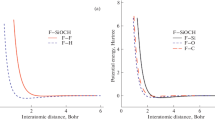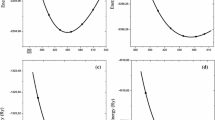Abstract
In this work, the optical properties of fluorine have been theoretically investigated. The Woods–Saxon potential model has been considered together with the spin–orbit interaction term. Then, the Schrödinger equation is solved by employing the Nikiforov-Uvarov method without and with considering the Coulomb term. We determine refractive index changes (RIC) and absorption coefficient (AC) of the fluorine with and without considering the Coulomb term. We found that (i) the RIC increases and shifts toward higher energies considering the Coulomb term. (ii) AC raises and moves to higher energies considering the Coulomb term. We also deduced that the Coulomb term has an important effect on the optical properties of fluorine.






Similar content being viewed by others
Data availability
The data that supports the findings of this study are available from the corresponding author upon reasonable request.
References
Ahn, D., Chuang, S.L.: Calculation of linear and nonlinear intersubband optical absorptions in a quantum well model with an applied electric field. IEEE J. Quant. Electron. 23, 2196–2204 (1987)
Aytekin, O., Turgut, S., Tomak, M.: Nonlinear optical properties of a Pöschl-Teller quantum well under electric and magnetic fields. Physica E 44, 1612–1616 (2012)
Aytekin, O., Turgut, S., Unal, V.U., Aksahin, E., Tomak, M.: Nonlinear optical properties of a Woods–Saxon quantum dot under an electric field. Physica E 54, 257–261 (2013)
Badalov, V.H., Ahmadov, H.I., Ahmadov, A.I.: Analytical solutions of the Schrodinger equation with the Woods–Saxon potential for arbitrary state. Int. J. Mod. Phys. E 18, 631–641 (2009)
Bayrak, O., Boztosun, I., Ciftci, H.: Exact analytical solutions to the Kratzer potential by the asymptotic iteration method. Int. J. Quant. Chem. 107, 540–544 (2007)
Dakhlaoui, H., Vinasco, J.A., Duque, C.A.: External fields controlling the nonlinear optical properties of quantum cascade laser based on staircase-like quantum wells. Superlatt. Microstrut. 155, 106885–106893 (2021)
Durante, F., Alves, P., Karunasiri, G., Hanson, N., Byloos, M., Liu, H.C., Bezinger, A., Buchanan, M.: NIR, MWIR and LWIR quantum well infrared photodetector using interband and intersubband transitions. Infrared Phys. Technol. 50, 182–186 (2007)
Esbensen, H., Bertsch, G.F.: Higher-order effects in the two-body breakup of 17F. Nucl. Phys. A 706, 383–390 (2002)
Ghanbari, A., Khordad, R.: Bound states and optical properties for Derjaguin-Landau-Verweij-overbook potential. Opt. Quant. Electron. 53, 152–163 (2021)
Ghanbari, A., Khordad, R., Taghizadeh, F.: Influence of Coulomb term on thermal properties of fluorine. Chem. Phys. Lett. 801, 139725–139731 (2022)
Hashemi, P., Servatkhah, M., Pourmand, R.: The effect of Rashba spin-orbit interaction on optical far-infrared transition of tuned quantum dot/ring systems. Opt. Quant. Electron. 53, 567–581 (2021)
Ikhdair, S.M., Sever, R.: Approximate eigenvalue and eigenfunction solutions for the generalized Hulthén potential with any angular momentum. J. Math. Chem. 42, 461–471 (2007)
Imamura, K., Sugiyama, Y., Nakata, Y., Muto, S., Yokoyama, N.: New optical memory structure using self-assembled in as quantum dots. Jpn. J. Appl. Phys. 34, L1445–L1447 (1995)
Jia, C.S., Zhang, L.H., Wang, C.W.: Thermodynamic properties for the lithium dimer. Chem. Phys. Lett. 667, 211–215 (2017)
Jia, C.S., Li, J., Liu, Y.S., Peng, X.L., Jia, X., Zhang, L.H., Jiang, R., Li, X.P., Liu, J.Y., Zhao, Y.L.: Predictions of thermodynamic properties for hydrogen sulfide. J. Mol. Liq. 315, 113751–113755 (2020)
Khordad, R.: Optical properties of quantum wires: Rashba effect and external magnetic field. J. Lumin. 134, 201–207 (2013)
Khordad, R., Avazpour, A., Ghanbari, A.: Exact analytical calculations of thermodynamic functions of gaseous substances. Chem. Phys. 517, 30–35 (2019)
Khordad, R., Rastegar Sedehi, H.R., Ghanbari, A.: Influence of non-uniform magnetic field on magnetic susceptibility, heat capacity, electronic and optical properties of a charged particle. Opt. Quant. Electron. 53, 630–641 (2021)
Kirak, M., Yilmaz, S.: Third harmonic generation of spherical multilayered quantum dot: effects of quantum confinement, impurity, electric and magnetic fields. Appl. Phys. A 128, 459–468 (2022)
Leobandung, E., Guo, L., Chou, S.Y.: Single hole quantum dot transistors in silicon. Appl. Phys. Lett. 67, 2338–2340 (1995)
Lu, L., Xie, W., Hassanabadi, H.: The effects of intense laser on nonlinear properties of shallow donor impurities in quantum dots with the Woods–Saxon potential. J. Lumin. 131, 2538–2543 (2011)
Mandelzweig, V.B.: Comparison of quasilinear and WKB approximations. Ann. Phys. 321, 2810–2829 (2006)
Miao, X.J., Sun, Y., Ma, X.J., Xiao, J.L.: Asymmetrical semi-exponential potential effect of exciton in strong-coupling alkali halide quantum well. Micro Nanostrcut. 163, 107137–107145 (2022)
Nasrallah, S.A.-B., Sfina, N., Said, M.: Electronic properties of intersubband transition in (CdS/ZnSe)/BeTe quantum wells. Eur. Phys. J. B 47, 167–170 (2005)
Nikiforov, A.F., Uvarov, V.B.: Special functions of mathematical physics. Birkhauser, Basel (1988)
Niknam, A., Rajabi, A.A., Solaimani, M.: Solutions of D-dimensional Schrodinger equation for Woods-Saxon potential with spin–orbit, coulomb and centrifugal terms through a new hybrid numerical fitting Nikiforov-Uvarov method. J. Theor. Appl. Phys. 10, 53–59 (2016)
Okon, I.B., Popoola, O.O., Omugbee, E., Antia, A.D., Isonguyo, C.N., Ituen, E.E.: Thermodynamic properties and bound state solutions of Schrodinger equation with Mobius square plus screened-Kratzer potential using Nikiforov-Uvarov method. Comput. Theor. Chem. 1196, 113132–113148 (2021)
Pahlavani, M.R.: Theoretical concepts of quantum mechanics, p. 225. Published by InTech (2012)
Pahlsavani, M.R., Alavi, S.A.: Solutions of Woods–Saxon potential with spin-orbit and centrifugal terms through Nikiforov-Uvarov method. Commun. Theor. Phys. 58, 739–743 (2012)
Pan, Y.: New insight into the structural, mechanical, electronic, and thermodynamic properties of the monoclinic TMAl3-type aluminides. Int. J. Quant. Chem. 122, e26825–e26834 (2022)
Rastegar Sedehi, H.R., Khordad, R., Bahramiyan, H.: Optical properties and diamagnetic susceptibility of a hexagonal quantum dot: impurity effect. Opt. Quant. Electron. 53, 264–274 (2021)
Sayrac, M.: Effects of applied external fields on the nonlinear optical rectification, second, and third-harmonic generation in an asymmetrical semi exponential quantum well. Opt. Quant. Electron. 54, 52–65 (2022)
Szego G.: Orthogonal polynomials, American Mathematical Society, US (1939)
Turkoglu, A., Dakhlaoui, H., Ramos, M.E.M., Ungan, F.: Optical properties of a quantum well with Razavy confinement potential: role of applied external fields. Physica E 134, 114919–114924 (2021)
Ungan, F., Ramos, M.E.M., Yesilgul, U., Sari, H., Sokmen, I.: Effect of applied external fields on the nonlinear optical properties of a Woods–Saxon potential quantum well. Physica E 111, 167–171 (2019)
Unlu, S., Karabulut, I., Safak, H.: Linear and nonlinear intersubband optical absorption coefficients and refractive index changes in a quantum box with finite confining potential. Physica E 33, 319–324 (2006)
Wang, C.W., Wang, J., Liu, Y.S., Li, J., Peng, X.L., Jia, C.S., Zhang, L.H., Yi, L.Z., Liu, J.Y., Li, C.J., Jia, X.: Prediction of the ideal-gas thermodynamic properties for water. J. Mol. Liq. 321, 114912–114917 (2021)
Woods, R.D., Saxon, D.S.: Diffuse surface optical model for nucleon-nuclei scattering. Phys. Rev. 95, 577–578 (1954)
Zhang, Z.H., Lui, C., Guo, K.X.: Electron–phonon interaction effect on the refractive index changes in a Modified-Pöschl–Teller quantum well. Optik 127, 1590–1594 (2016)
Funding
The authors have not disclosed any funding.
Author information
Authors and Affiliations
Corresponding author
Ethics declarations
Conflict of interest
The authors declare that there is no conflict of interests regarding the publication of this paper.
Additional information
Publisher's Note
Springer Nature remains neutral with regard to jurisdictional claims in published maps and institutional affiliations.
Appendices
Appendix A
In this part, we have presented the NU method. The procedure as a powerful mathematical tool is employed to solve the second-order differential equations using the special orthogonal functions (Turkoglu et al. 2021). Consider the below equation
where \(\eta \left(z\right)\) and \(\gamma \left(z\right)\) are second-order polynomials and \(\lambda \left(z\right)\) is a first-order polynomial. We use the following function.
Therefore, we obtain
and
The function \(y(z)\) is of the hypergeometric type. It can be written as (Ahn and Chuang 1987)
where \({\alpha }_{n}\) is the normalization constant. To solve Eq. (20), the following relations should be satisfied
Appendix B
To solve Eq. (4), we used the following approximation
where \({r}_{m}\) is a minimum point, \(\rho =\frac{1}{a}\), and \(p={e}^{\rho {R}_{0}}\). Now, we employ the new variable as \(z=-{e}^{-\rho r}\). Thus, we can express Eq. (4) as follows.
We define the three following variables
Now, Eq. (27) reduces to the NU equation as
By comparing Eq. (31) with the NU equation, we can obtain the energy levels of Eq. (5).
Appendix C
To solve Eq. (6), we consider the following Coulomb term for fluorine (Khordad et al. 2021)
We use the new variable \(\phi \left(r\right)=rR(r)\) and obtain
We employ another variable as \(t={e}^{-\rho r}\) and the following approximation
We obtain
We simply above equation and obtain
To convert the above equation with the NU equation, we use the following approximations (Khordad et al. 2021)
By using the above approximation, Eq. (36) convert to the NU equation, and we can obtain the energy levels of Eq. (7).
Rights and permissions
Springer Nature or its licensor holds exclusive rights to this article under a publishing agreement with the author(s) or other rightsholder(s); author self-archiving of the accepted manuscript version of this article is solely governed by the terms of such publishing agreement and applicable law.
About this article
Cite this article
Ghanbari, A., Khordad, R. & Sedehi, H.R.R. Effect of Coulomb term on optical properties of fluorine. Opt Quant Electron 54, 789 (2022). https://doi.org/10.1007/s11082-022-04184-8
Received:
Accepted:
Published:
DOI: https://doi.org/10.1007/s11082-022-04184-8




